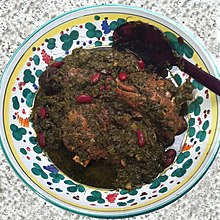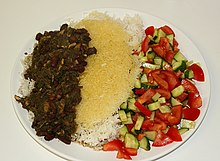Ghormeh sabzi
 | |
| Alternative names | Khoresh sabzi, khoresht sabzi, ghormeh sabzi, qormeh sabzi |
|---|---|
| Type | Stew |
| Course | Main course |
| Place of origin | |
| Associated cuisine | |
| Created by | Iranians |
| Main ingredients | Herbs, kidney beans, dried lime, lamb; served with rice. |
Ghormeh sabzi (Persian: قورمه سبزی) or Khoresht sabzi (Persian: خورشت سبزی), also spelled qormeh sabzi, is an Iranian herb stew. It is considered the national dish and is a very popular dish in Iran.[1] Ghormeh sabzi has different variants, which are based on the difference between beans and meat.
Preparation
[edit]
The main ingredients are a mixture of sauteed herbs, consisting mainly of parsley, leeks or green onions, and coriander, seasoned with the key spice of dried fenugreek leaves. The herb mixture has many variations.[2] Any dark bitter greens can be used, such as kale, mustard greens, or turnip greens, although none of those is part of the original recipe.[3]
This mixture is cooked with kidney beans, yellow or red onions, black lime (pierced dried limou-Amani Persian lime), and turmeric-seasoned lamb or beef. The dish is then served with polo (Persian parboiled and steamed rice) or over tahdig.[4]
The Financial Times noted that there is much disagreement among Iranians on the ingredients used in the stew.[5]
Serving
[edit]Ghormeh sabzi, a flavorful stew, is traditionally served with basmati rice. However, it can also be eaten with flatbread, Shirazi salad (cucumbers, tomatoes, onions, and herbs), and a yogurt-cucumber dip.[6][better source needed][7]
Cultural importance
[edit]Self magazine listed ghormeh sabzi as one of twelve of the most meaningful dishes among cultures passed down among families.[8] The Tehran Times wrote that the dish "is one of the most prominent dishes in Persian culinary heritage."[9]
The undisputed King of Persian stews is Ghormeh Sabzi, with the Queen being Fesenjan, a pomegranate and walnut chicken stew. The crown jewel of this dish is its unparalleled depth of flavor. A symphony of fenugreek, cilantro, parsley, and dried limes creates a savory-sour symphony, enhanced by the comforting richness of beef and kidney beans.[10]
Iranians in the diaspora traditionally celebrate "International Ghormeh Sabzi Appreciation Day" two days after Thanksgiving.[11]
Ghormeh sabzi is the first Iranian dish served in outer space, by astronaut Jasmin Moghbeli.[12]
See also
[edit]References
[edit]- ^ Dana-Haeri, Jila; Ghorashian, Shahrzad; Lowe, Jason (2011). New Persian Cooking: A Fresh Approach to the Classic Cuisine of Iran. I. B. Tauris. p. 79. ISBN 978-1848855861.
- ^ "Persian Stew Recipe Iranian Ghormeh Sabzi International Cuisines". YouTube (in Japanese). 14 September 2020. Retrieved 14 June 2022.
- ^ HasanzadeNemati, Shadi (3 January 2018). "Ghormeh Sabzi - Persian Herb Stew (Video)". Unicorns in the Kitchen.
- ^ Benayoun, Mike (11 December 2022). "Ghormeh Sabzi".
- ^ Patalay, Ajesh (3 September 2020). "Where to eat Persian food – just as mother makes it". Financial Times. Retrieved 22 January 2021.
- ^ "Explore Persian Ghormeh Sabzi: A Flavorful Herb Stew from Iran's Rich Culinary Heritage". Cooking County. Retrieved 7 April 2023.
- ^ Marzia (16 February 2023). "Ghormeh Sabzi Recipe (Persian Herb Stew)". Little Spice Jar. Retrieved 1 April 2024.
- ^ Shiffer, Emily (20 January 2021). "12 People on the Meaningful Food Traditions Passed Down in Their Families". SELF. Retrieved 22 January 2021.
- ^ "Persian cuisine: Khoresh-e Ghormeh Sabzi (Persian herb, bean and lamb stew)". Tehran Times. 14 August 2020. Retrieved 22 January 2021.
- ^ Prewer, Mersedeh (6 March 2024). "Ghormeh Sabzi". The Mediterranean Dish. Retrieved 11 June 2024.
- ^ KUMS. "Ghorme Sabzi". KUMS. Retrieved 22 January 2021.
- ^ "قرمهسبزی ایرانی به فضا رفت". euronews (in Persian). 12 February 2024. Retrieved 12 February 2024.
